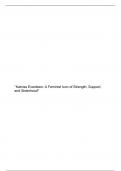"Katniss Everdeen: A Feminist Icon of Strength, Support,
and Sisterhood"
, Introduction
In the dystopian universe of "The Hunger Games," where survival is a harsh contest, the
intricate interpersonal dynamics between Katniss Everdeen and her female counterparts
unfold as a captivating narrative within the broader landscape of feminist film theory.
Originating in the early 1970s, feminist film theory sought to dissect cinema as a cultural
practice actively constructing myths surrounding women and femininity.1 The research
question that is going to be explored is: How do Katniss’s interpersonal dynamics with other
females in the first “Hunger Games” movie contribute to a feminist analysis within the
cinematic narrative?
Upon its release in 2008, The Hunger Games introduced readers to a strong female
protagonist, garnering approval within the young adult literature community.2 Katniss, the
bow-wielding and assertive character, showcases an independent spirit, dismissing
traditional feminine adornments, and shielding herself from emotions that might expose
vulnerability.3 However, amid the enthusiasm for Katniss's formidable persona, it's crucial to
recognize that her survival in the arena is not solely attributed to superior strength, speed, or
intelligence. Instead, her ability to form meaningful relationships becomes the cornerstone of
her resilience.4 It’s not merely the weapons Katniss brandishes but the connections she
nurtures that become instrumental in preserving her life.5
Feminist film theory, marked by its (post)structuralist roots, delves beyond conventional
critiques of stereotyped representations of women in classical cinema.6 It pioneers a
nuanced approach, recognizing cinema as a medium that not only reflects but actively
shapes societal norms and gender ideologies. Within this theoretical framework, Katniss
Everdeen's relationships become a lens through which the portrayal of women's agency,
solidarity, and resistance to traditional gender norms is explored which are all pivotal
elements within feminist cinematic discourse.7
The chosen research question becomes a crucial intersection where the narrative nuances of
"The Hunger Games" converge with the theoretical underpinnings of feminist film discourse.
By examining how Katniss interacts with other female characters, the aim is to unveil the
film's engagement with the feminist principles of challenging or reinforcing traditional gender
roles.8 This exploration is rooted in the evolving landscape of feminist film theory, which has
transitioned from early critiques of sexist images to incorporating diverse perspectives on
ethnicity, masculinity, and queer sexualities.9
In navigating this cinematic terrain, the methodological choice of discourse analysis emerges
as a fitting tool. Discourse analysis, within the context of feminist film theory, provides a
means to decipher not only what is spoken and shown but also the underlying ideologies,
power structures, and subject positions at play.10 The method aligns seamlessly with the
theoretical shifts within feminist film discourse, emphasizing the importance of understanding
how discourse constructs meaning, power, and ideology.11
11 Anne Smelik, “Feminist Film Theory,” The Wiley Blackwell Encyclopedia of Gender and Sexuality Studies First
Edition, Edited by Nancy A. Naples, (2016):1, DOI: 10.1002/9781118663219.wbegss148.
2 Thomas P, Fair, “Theorizing Space and Gender in the 21st Century” Rocky Mountain Review vol. 69, no. 1
(SPRING 2015): 90, http://www.jstor.org/stable/24372866.
3 Fair, “Theorizing Space and Gender,” 91.
4 Fair, “Theorizing Space and Gender,” 91.
5 Fair, “Theorizing Space and Gender,” 91.
6 Smelik, “Feminist Film Theory,” 1.
7 Smelik, “Feminist Film Theory,” 1-2.
8 Smelik, “Feminist Film Theory,” 1-2.
9 Smelik, “Feminist Film Theory,” 1-2
10 Jane, Stokes, "Why Do We Do Media and Cultural Studies?” In SAGE Publishing, 2002, Chapter 5, 144.
11 Stokes,"Why Do We,” 147-148.




